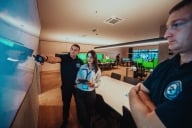You have /5 articles left.
Sign up for a free account or log in.
In October 2005, an article appeared in the journal Science that piqued the federal government’s interest. It was titled “Characterization of the Reconstructed 1918 Spanish Influenza Pandemic Virus.” The Spanish Flu Pandemic killed 50 million to 100 million people. And there, in the pages of America’s most prestigious scientific journal, was the formula for destruction.
With the concurrent rise of the biological sciences and of national security concerns, the safety of disseminating research findings has become an important issue. One of the biggest questions for higher education is how to balance legitimate national security concerns without hampering the free flow of information.
The committee of the Government-University Research Partnership: Balancing National Security and Open Scientific Communication Post September 11th, met for the first time Thursday to consider these issues. The committee, sponsored by the National Institutes of Health, the Department of Health and Human Services, and the National Science Foundation, hopes to issue a report in the fall.
The flu article in Science was accompanied by an editorial extolling the virtue of free flowing information. And it was soon met by a New York Times editorial lambasting the release of dangerous information. “The papers were important for public health,” said Amy P. Patterson, director of the Office of Biotechnology Activities at NIH, at the meeting at a National Academies building in Washington. “But as scientists, we need to be responsive [to security concerns].”
If academic scientists do not become responsive to security concerns, they could see the information hose cinched in the future. It was only the NIH’s creation of Institutional Biosafety Committees in 2002, more than 300 of which are at academic institutions, that kept Congress from prohibiting recombinant DNA research, Patterson said.
One question that committee members had for the experts who spoke was: How well can the government enforce restrictions on academic research? In some cases, the answer was: not well at all. Richard A. Meserve, a committee member and president of the Carnegie Institution of Washington, said that, even if the editor of Science sensed security issues with an article, “a persistent author can always get an article published somewhere.” Meserve wondered what kind of penalties there are for publishing information that could be used to cause harm.
“There are no current penalties, so we rely on self-regulation,” Patterson said. Added Arthur I. Bienenstock, committee member and vice provost and dean of research and graduate policy at Stanford University: “It would appear the nation’s security depends on these IBCs. Is there an accreditation process?” Patterson replied that there is not.
Nonetheless, the general tone of the committee was that academic research must remain as free as possible, lest the U.S. position in the world be jeopardized by a lack of progress, as opposed to a lack of security. Michelle Van Cleave, head of U.S. counterintelligence, said she hopes academic researchers will take a more complex view about sharing, not only with the world, but even with colleagues. She described looking through reports on Cold War espionage, both economic and military, when she first took her position.
“The extent of what was lost to espionage was greatly beyond what I had expected,” Van Cleave said. “Had we gotten into a shooting war with the Soviet Union, what had been compromised by espionage could have made the difference in that war. Now we are in a shooting war,” she added. Van Cleave said that some spying techniques are “old fashioned.” She said that sometimes someone with bad intentions, perhaps even another scientist, will “make a phone call, start talking,” and that American researchers could be especially vulnerable because we “believe in the free exchange of ideas,” and the conversation might seem relatively benign.
In some cases, though, even the old fashioned chatting might land a researcher in hot water. Under the Department of Commerce’s “deemed export” rule, researchers who “release technology” to foreign nationals from particular countries, excluding those with green cards, must have an export license. “Release,” in this case, is broadly defined, sometimes including information deliverable in a conversation.
“From the academic’s viewpoint, there is no justification for a push into academia of deemed exports,” Bienenstock said. But Richard A. Johnson, a lawyer who specializes in biotechnology, said that Congress has been “going out to universities and saying, look we’re not going to prosecute you unless it’s egregious, but you are not exempt. The liability, it’s broad, it’s real.”
The committee worried that academics would avoid certain topics of study because of liability. Already, some have had to avoid collaborating with graduate students from Cuba, Iran, Libya, North Korea, Sudan, and Syria, who, according to the Patriot Act, are not allowed to work with any of a list of about 100 “biological agents.” Alice Gast, committee member and vice president for research and associate provost at the Massachusetts Institute of Technology, acknowledged that “exporting is not a right, but speech is,” she asserted, suggesting that the deemed export rule is “more troublesome” if it goes so far as to apply to conversations.
As far as the most troublesome technology, experts pinpointed synthetic genomics. Scientists can make the entire genome of small viruses, with precious few guidelines. “We’ve had reports from [gene] providers that they’ve gotten requests to synthesize genomes, but not [identify the resulting organism] because it’s a trade secret,” Patterson said. She added that most of the providers are private, but that universities are sometimes involved. “Could somebody be synthesizing the small pox genome and shipping it without knowing?” she asked.
In some cases scientists are synthesizing organisms that do not exist in nature, and wouldn’t be on any watch list anyway. Thus, in those instances, the handling of sensitive information falls solely to the researcher, a position many academics are not used to. In the case of the Spanish Flu paper, the work was done by scientists at the Center for Disease Control and Prevention, and the government, with some reservations, cleared it for publication. In many cases, the government will only be clued in after publication anyway.
“We’ve enjoyed a lot of freedom,” Patterson said. “We need a shift to a culture of responsibility. The challenges are great, the stakes are high,” Patterson said. For both America and academe.








